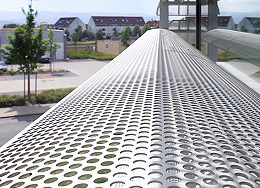
Thống kê
| 1882834 | |
| Số người đang online | 1 |
| Số truy cập hôm nay | 244 |
| Số truy cập tháng này | 57974 |
Quảng cáo
Establishment of stainless steel - stainless steel
|
Stainless steel, also known as inox is a form of iron alloys containing minimum 10.5% chromium. It is less prone to discoloration or corrosion like other ordinary steel. Stainless steel attached to the name of a British steel industry experts are Harry Brearley. When in 1913, he invented a special type of steel with high wear resistance, by reducing the carbon content down into components for chromium steel (0.24% to 12.8% C and Cr).
Stainless steel, also known as inox is a form of iron alloys containing minimum 10.5% chromium. It is less prone to discoloration or corrosion like other ordinary steel.
Stainless steel attached to the name of a British steel industry experts are Harry Brearley. When in 1913, he invented a special type of steel with high wear resistance, by reducing the carbon content down into components for chromium steel (0.24% to 12.8% C and Cr).
Then the steel company Krupp in Germany continued to improve this steel by adding nickel to steel elements to improve corrosion resistance to acids and soften more easily worked. Based on this discovery that two kinds of steel grade 400 and 2 300 born shortly before World War First. After the war, the 20s of the 20th century, a British steel industry expert Mr. W. H Hatfield continued research and development of the idea of stainless steel. By combining the different ratio between nickel and chromium in the steel sectors, he has introduced a new type of stainless steel 18/8, who 8% Ni and 18% Cr, is the familiar steel grade 304 of today. He is also the inventor of the 321 steel by adding titanium to steel composition ratio above 18/8.
After nearly a millennium, the advent and development, today stainless steel is widely used in all areas of civil and industrial with over 100 different steel grade.
In the metallurgical industry, the term stainless steel (stainless steel) is used to describe a form of iron alloys containing minimum 10.5% chromium. Called "stainless steel" but actually it's just iron alloys do not change color or corrode easily as conventional steels. This material may also be referred to as anti-corrosion steel. Typically, there are many different ways to apply stainless steel for different surfaces to increase the longevity of materials. In life, they appear everywhere as the blades cut or strap watches ...
Stainless steel is resistant to oxidation and corrosion is very high, but the choice of the right type and their technical specifications to fit in each particular case is very important.
Resistant to oxidation from the surrounding air at normal temperature of stainless steel is due to the ratio of chromium in the alloy (as low as 13% and can be up to 26% in the case of work in harsh working environments). Oxidized state of chromium oxide, chromium usually (III). When chromium alloy steel in contact with air is a very thin layer of chromium oxide III appeared on the surface of the material; This thin layer that can not be seen with the naked eye, meaning the metal surface is still shiny. However, they absolutely do not react with water and air, it protects the steel layers underneath. This phenomenon is called the oxidation rust engineered materials. We can see this phenomenon for some other metals such as aluminum and zinc in.
When these objects made of stainless steel are linked together with forces acting as bolts and rivets, the oxide layer of them may fly off at the location where they are connected together. When disassemble them out, you can see those placements corrosion.
Nickel and lip-black modules and vanadium also features stainless oxidation similar but not widely used.
Besides chromium, nickel and lip-black modules and nitrogen oxidation also features similar rust.
Nickel (Ni) is a common ingredient to enhance viscosity, easy bending, shaping properties of stainless steel. Model-lip-black (Mo) makes stainless steel resistant to corrosion in acidic environments. Nitrogen (N) create stability for stainless steel in subzero temperatures (cold environment).
The participation of the various components of chromium, nickel, lip-black module, nitrogen lead to different crystal structures generate various physical properties of stainless steel.
Stainless steel is resistant to oxidation and corrosion is very high, but the choice of the right type and their technical specifications to fit in each particular case is very important.
There are four major types of stainless steel: austenitic, ferritic, austenitic-ferritic (duplex), and martensitic.
Austenitic stainless steel is the most common. Under this line may include the steel grade SUS 301, 304, 304L, 316, 316L, 321, 310s ... It contained the minimum 7% nickel, 16% chromium, carbon (C) 12:08% max. Such components created for this steel has high corrosion resistance in wide temperature range, not magnetized, flexible, pliable, easy to solder. This steel is used to make many household appliances, containers, industrial pipe, industrial ships, exterior architecture, the other buildings ...
Ferritic stainless steel is the mechanical properties similar to mild steel, but potentially higher corrosion resistant mild steel (low carbon steel). Under this line may include the steel grade SUS 430, 410, 409 ... This type containing approximately 12% - 17% chromium. This type, with 12% Cr is often much in architectural applications. Type containing approximately 17% chromium is used for household appliances, boilers, washing machines and indoor architecture ...
Austenitic ferritic-(Duplex) This type of steel has properties "in the middle" ferritic and austenitic type collectively called DUPLEX. Under this line may include LDX 2101, SAF 2304, 2205, 253MA. Duplex steel contains less than Ni austenitic type. DUPLEX with features typical of high-strength reliability and flexibility to be used in the petrochemical industry, paper, pulp, manufactured Ship ... Given the escalating price of stainless steel nickel scarce due DUPLEX lines are increasingly being applied more to substitute for some grades of austenitic steels such as SUS line 304, 304L, 316, 316L, 310s ...
Martensitic type contains about 11% to 13% Cr, bearing strength and hardness, corrosion resistance relative degree. Used more to manufacture turbine blades, blades ...
Source: Wikipedia
|
Liên kết website
Hỗ trợ trực tuyến
-
 Liên hệ ngay.Email:ĐT: (08) 6682 3335 - Fax: (08) 6256 2218
Liên hệ ngay.Email:ĐT: (08) 6682 3335 - Fax: (08) 6256 2218
Ngày giờ hiện tại
13/9/2025
clock




